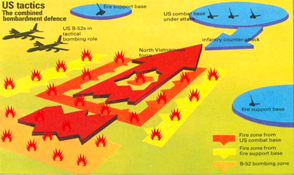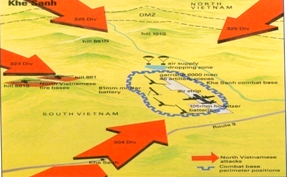Basic Causes of the Indochina War
There were many factors that caused the Indochina War, including colonization by the Western World. Great-Britain controlled and/or exercised deep influence in many Asian countries, and France took over the Indochina countries of Cambodia, Laos and Vietnam as either colonies or protectorates. The French and the Siamese used the Mekong River as the borderline for administrative purposes, leaving territories on the right bank of the river under Siamese control and the left bank territories, under the control of the French (and the Vietnamese, who wanted to be the masters of the three Indochina countries). Following the end of the Second World War II in 1946, the Siamese government under Prime Minister Pridi Phanomyong agreed to return the Lao provinces of Sayabouri and Champasak to the French basically to:
- Secure French support for Siam’s admission as a member of the United Nations
- Eliminate any financial repayments for the damages caused by Siam during the war, and
- Maximize Siam’s chance for massive assistance from the US.
As for the French, they resumed their power in Indochina and forced Siam to return the two provinces of Sayabouri and Champasak to Laos in 1946, territories that the Lao Issara and the Vietminh had been using as their regroupment zones in their fight against the French.
Before the colonial age, the Mekong River was flowing freely across the large Lao territory as mentioned in many popular songs and poems. Foreign domination accelerated nationalist feelings and the thirst for independence of the people of Laos, Vietnam and Cambodia. They were also encouraged by other countries to move in that direction for the sake of human rights and individual freedom. As a result, a large part of the population stood up to fight against the French right at the start of the Second World War II in order to recover independence from France. The Lao national rebellion movement joined forces with similar movements in neighboring countries of Vietnam and China, trying to secure military assistance and troops from those countries. In the end, those programs became national debts and obligations that were extremely difficult to repay, and made our country the slave of the donor countries, adding pain to injuries.
The French regime had positive and negative impacts, but in retrospective, one was always wondering why the Lao did not learn from their fight against the French and use those lessons strategically and conceptually to their advantage. Wouldn’t that be a better way out than an armed fight? In time of changes, there are always pluses and minuses. We need to gage which ways hold the most promises before deciding to move in the most favorable direction. Transformations always take time and require patience before showing any results. We should not use resentment and reactive mood if we want to avoid being taken advantage of by ill-intentioned people.
An armed fight made us the servants of countries that provided assistance to us and used a regime that we did not fully understand, like the Lao communist party. As a result, the Lao communists brought in a new administrative system. They also made our country a neo-colony of communist Vietnam, who came in to dominate us, took us back to the Dark Age, denied us freedom of speech, and shut our mouths so they could take away all our country’s natural resources.
Ho Chi Minh, founder of communist North-Vietnam, used to make a statement at a Vietminh party meeting in 1929, “We accepted to be French servants, but we have to be prepared to be the Lao and Khmer bosses in Indochina.” Ho Chi Minh studied communism in France and underwent additional training in Russia. Once he became a communist expert, he returned to Thailand to begin the fight to push the French out of Indochina. At that time, Thailand adopted an anti-French position and gave Ho Chi Minh a good chance to start his fight for independence in Thailand. The timing was right as it coincided with the start of the World War II initiated by Hitler in Europe. In Asia, Japan also rose up to free itself from western influence. This was a good opportunity for Ho Chi Minh to receive arms and ammunitions from the US and get ready to fight Japan alongside the US. When Japan lost the war, it also left several types of weapons with Ho Chi Minh and Thailand for use in national liberation fights.
Right before the start of World War II, Russia also underwent deep political changes. The communist party headed by Lenin, who led the revolution against the former tsarist regime and killed all the members of the Russian royal family except for a small girl who was able to escape, paved the way for Ho Chi Minh. In early 1945, once he was well equipped with weapons, Ho Chi Minh resolutely began his fight against the French who were then heavily attacked and pushed around by the Germans.
The New World After World War II
The end of World War II marked the beginning of the communist war that split the world into two camps: the eastern camp and the western camp.
- The eastern camp consisted of pro-communist countries, including Soviet Russia, Red China and several other communist countries.
- The western camp, led by the US and its allies in Europe, consisted of free democratic countries that were well united up until the loss of Dien-Bien-Phu, when several international conflicts arose.
In 1949, the pro-communist Chinese won their internal fight against the nationalist Chinese and put the entire country of China under a communist regime led by Mao Zedong that was receiving assistance from Russia. In 1950, the Korean War started, prompting the US to deploy armed forces to assist free South-Korea fighting communist expansion. Korea was then divided into two parts:
– North-Korea, under a communist regime backed by Red China and Russia
– South-Korea, a democratic country with strong backing from the US
Ho Chi Minh joined the Communist World in 1951. He sent many divisions of North-Vietnamese troops for military training along the borderline of Laos, Vietnam, and China. This caused the West (USA and France) to be worried about the expansion of communism into southeast-Asia (Thailand, Vietnam, Laos, Cambodia, etc.).
In 1951, Indochinese communists interfered in many ways in the internal affairs of Laos, over and under the table, including pulling Prince Souphanouvong into their camp. Dwight Eisenhower, who became the US President in 1953, was very concerned about the situation in Asia. He once declared, “If we lose Laos, it would as if we lost the entire south-east Asia.” He joined hands with France’s President, Gen. Charles de Gaulle, in developing a plan of defense against communist expansion, setting up the military camp of Dien-Bien-Phu at a critical location between China and Laos in early 1952 as a strong signal to the communist side. The French dedicated a lot of efforts in the establishment of Dien-Bien-Phu, and deployed no less than 30,000 regular troops and several thousands of regional guards to that camp and the surrounding valley areas. The idea was to lure communist troops up in the higher elevations and have them fight from there, because it was easier to attack them that way, especially dropping bombs on them. This was not something that the communists would like to do, as they usually carried heavy equipment and have not used that attack strategy very often.
In December 1952, North-Vietnam did everything they could to help the Lao Issara capture Samneua and Phongsaly Provinces, believing that these provinces used to be the Lao Issara strongholds. In reality, what they did was to send troops to encircle the Dien-Bien-Phu base and cut the French reinforcement and support line as part of the overall strategy for China to attack from the north, and North-Vietnam to attack from the south. The US and France agreed that France should be deploying troops and weapons to reinforce the local forces around Dien-Bien-Phu and that the US would be providing air support. So, France did the troop deployment between early November 1953 and January 1954, but the US didn’t do what they had agreed to do and, instead, sided along with Ho Chi Minh. The US was talked out of helping France fight the Vietminh because that would be against the US policy of not helping an old colonial power (France) regain its old colonial territory (Vietnam). Therefore, the US agreed with Ho Chi Minh to start negotiations in Geneva, Switzerland on May 21, 1954.
The Vietminh took advantage of the situation and attacking Dien-Bien-Phu fell on May 7, 1954, two weeks before the scheduled Geneva negotiation on May 21, 1954. The US decision to get involved was uncertain because they underestimated Ho Chi Minh and was not yet aware that he was an executive member of the international communist party. The fall of Dien-Bien-Phu made France very unhappy with the US, who then refused to sign the Indochina peace accords as planned for July 20, 1954. This situation caused France to change its strategy and collaborate with the communists. As a result, several Frenchmen ended up spying and looking for signals on the US strategy and feeding them to the Vietnamese communists.
Furthermore, the US generated fear of communism in many countries around the globe “in Asia, Europe, and Latin America” and indirectly pushed many of those countries to collaborate with the communists. The political situation in the US and other relatively nearby countries like Cuba, Nicaragua, and Argentina was in turmoil; many issues also surfaced in Europe. This prompted US President Kennedy to begin an overseas war in the Indochina peninsula, instead of allowing one to occur around the US or in the US itself. The US did not need to win the war; it was more interested in testing its new weapons on the communists, and getting a feel for how destructive such a fight would be. Two good examples included the battles of Khe-Sanh in the end of 1967 and Hue on February 27, 1968 which the US qualified as “hopeless fights”.
As a result, the US political situation changed drastically. Because of those changes, Gen. Vang Pao and the US forbid French aircrafts or Frenchmen to come to Long Cheng or MR-II. The US didn’t allow any French newsmen in Hue, South-Vietnam either.
After the communist North-Vietnam’s victory at Dien-Bien-Phu, Vietnam became a two-part country –the North and the South.
North-Vietnam
The communist party took the opportunity to infiltrate very dangerously into South-Vietnam, and forced the US to come out and monitor the situation on the spot. This led to other events, including the coup d’état mounted by Kong Le in Vientiane, Laos. The Geneva Accords of 1954 forbid all foreign interferences in the kingdom of Laos, and the French themselves had assured Laos that whenever communist Vietnam were to disregard those Accords, they would be the first country to immediately come to Laos’ rescue.
After Kong Le mounted his coup d’état, North-Vietnam smartly allowed him to pick Prince Souvanna Phouma –who had just been named Laos Ambassador to France not long before—as the new Prime Minister of the Laos government. The prince was married to Aline Allard, a half-French lady born in Laos, and was the Lao leader that the French trusted the most. When Souvanna Phouma proclaimed Laos’ policy of neutrality, the French were flabbergast and chose not to help Laos anymore. Prince Souvanna Phouma then turned to Red China, North-Vietnam, Russia and the communist world for help. Those countries openly sent in weapons, war materials and North-Vietnamese troops to help the new Laos revolutionary government in Vientiane. Between the start of the coup d’état and Kong Le’s retreat to the Plain of Jars, huge Russian Ilyushin jets continuously flew in to drop supplies at the Wattai Airport, Kasy, Muang Soui, and the Plain of Jars hundred times a day, from morning to sunset.
Once they witnessed those activities, the US decided to provide military assistance to Prince Boun-Oum Na Champasak and Gen. Phoumi Nosavan. This led to direct US field participation in an attempt to control communist expansion to South-Vietnam and South-east Asia. US President Kenney decided to take part in the Indochina war from 1963 on, a war referred to as “10,000 day war”. This turned out to be the longest war fought by the US in its history. This was a war where you heard a lot of gun shots but saw nobody. The jungle was dense and full of wild animals. The weather was also different than in the US.
In 1970, Cambodia’s King Sihanouk had to seek refuge in China because of Gen. Lon Nol’s coup d’état, and the fact that the US and South-Vietnam needed Gen. Lon Nol’s help. Sihanouk proclaimed Cambodian neutrality but Cambodia had to allow passage trails and hiding spots to North-Vietnamese troops on their way to South-Vietnam. Both Sihanouk and Souvanna Phouma adopted the same policy. Therefore, when Gen. Kouprasith Abhay attacked Vientiane after Kong Le mounted his coup d’état, Prince Souvanna fled to Cambodia.
South-Vietnam
South-Vietnam became a free country after the French retreat in 1954, although there were still quite a few Frenchmen left behind, mainly businessmen. Eventually, those tradesmen also had to leave south-Vietnam little by little, causing some concerns to several Vietnamese leaders and prompting various kinds of appeals and negotiations. In the end, a coup d’état took place. The country had to request assistance from the US to counter communist expansion to South-Vietnam. This was the main reason for the start of the Indochina war.
In 1969, Soviet Russia and Red China had a border fight along their areas. Between 1951 and 1969, the Indochina Communist Party (ICP) rarely did anything openly, but after the US President Nixon’s visit to China on February 21, 1972 the ICP started playing a key role in several important decisions, including the appointment of Kaysone Phomvihane as Secretary General of the Lao Communist Party, leaving Prince Souphanouvong as leader by name only, without any real power. Prince Souphanouvong’s own son was killed by Lao communists in Samneua, Houaphan Province, with the Hmong being blamed as the killers.
Why Did the US Leave Indochina?
In fact, the US forces did not lose the Vietnam War. President Nixon made in chapter 8, page 219 of his Memoirs, “Why the North won the Vietnam war?” the following statements, “We lost the war because of our own people. Ho Chi Minh was just the one that reaped the benefits.” This was really true because of the unexpected changes in the US political scenery punctuated by student and public heavy demonstrations against the government in 1965 and 1966. In 1972, those demonstrations had to be harshly controlled by police forces, causing the death of several demonstrating students in Tennessee and Ohio. The Watergate scandal forced President Nixon to leave office in 1974 and be replaced by Vice-President Ford. These events prompted the US to spend more attention to its internal affairs, instead of Vietnam affairs, that occurred far away and had less of an immediate impact on the US. Hence, Indochina easily went under North-Vietnam’s control without any choice.
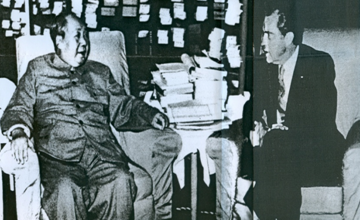 Photo #199. President Nixon met with Chairman Mao Ze Dong in Bejing in 1972 (after USSR-China border conflict in 1969).
Photo #199. President Nixon met with Chairman Mao Ze Dong in Bejing in 1972 (after USSR-China border conflict in 1969).
In 1967, communist Vietnam attacked the entire kingdom of Laos and South-Vietnam. A French journalist met with Gen. Vo Nguyen Giap (North-Vietnam’s military tactical commander) and asked him, “America is a powerful nation; how do you feel about fighting against America?” Gen. Giap replied, “A second Dien-Bien-Phu in South-Vietnam is unavoidable.” The French journalist had no further questions, took off and went on to meet with Gen. Westmoreland, US Military Commander in South-Vietnam. He asked the US General, “What do you think about Gen. Vo Nguyen Giap’s statement that ‘A second Dien-Bien-Phu is bound to occur in South-Vietnam’?” Gen. Westmoreland replied, “I don’t know. Go and ask my deputy-Commander in Hue.” The French journalist wanted to go to Hue, but the US would not allow any French journalists in for security reason. After the French journalist left, Gen. Westmoreland called a meeting with his senior staff to discuss Gen. Giap’s hints about a second Dien-Bien-Phu battle in South-Vietnam.
How would that battle occur and where? The following were possible North-Vietnamese attack scenarios that were discussed.
- Deployment of troops from the China Sea. This scenario would be impossible because North-Vietnam did not have adequate Navy forces and were not ready for this type of attack from the sea. It would be tantamount to suicidal bees intentionally flying into a burning fireplace.
- Deployment of troops across the demilitarized zone. This scenario was not any more feasible either, because the whole world would accuse North-Vietnam of invading South-Vietnam. Besides, North-Vietnam would have to use massive and well-equipped armed forces to have any chance to attack the allied forces in a region that was within the firing range of the US Navy ships operating in the China Sea. This scenario would be highly risky for North-Vietnam’s army.
- Deployment of troops through the jungle along the Laos/Cambodia border to invade South-Vietnam. This was the option that North-Vietnam had and would probably like to use.
Following that meeting, the US commanders in South-Vietnam decided to establish the Khe-Sanh military base near Sepone and to close to the border between South and North Vietnam. Khe Sanh was a very well fortified camp with about 6,000 troopers and pro-US Montagnard soldiers deployed in the front line and South-Vietnamese soldiers in the middle. The whole base stretched over eight miles, packed with a series of interlinked posts to facilitate troop movements back toward the two square mile nucleus area. The US installed barbed wire fences all around and planned to add improvised explosive devices at selected spots as well. The whole complex, completed in the end of 1967, was equipped with electronic equipment capable of detecting the size of the invading troops and their movement.
The North-Vietnamese watched the construction of this base closely and developed a plan to attack it as soon as it was completed. Gen. Vo Nguyen Giap deployed an armed force of over 60,000 troopers (ten times more than the US-allied troops) for the Khe-Sanh attack. These troops first attacked the front line units stationed eight miles away from the central command center, and pushed them back four miles inside. The allied troops moved back and regrouped inside the 2-mile nucleus, under a plan to wait until the enemy reached the bombing target zone before ordering B-52’s in. However, the enemy’s attack was too strong, the US had B-52’s dropping bombs immediately by waves of one B-52 after the other.
After the bombing, the US troops knew exactly the enemy’s status thanks to the electronic sensors that were put in place. Because of the heavy losses his troops suffered at Khe-Sanh and to distract attention, Gen. Vo Nguyen Giap ordered the communist attack on Hue during New-Year holidays, causing serious damages to both sides.
In April 1968, the fighting still continued at Khe-Sanh through artillery firing. The US dispatched helicopters to round up all the allied troops and announced that the Khe-Sanh base has been seized by the communists. Several helicopters were shut down during the air evacuation operation. Gen. Vo Nguyen Giap learned very painful lessons from this battle. Of the 60,000 troops, only 10,000 survived, some of them badly injured.
After that, the French journalist came back to see Gen. Vo Nguyen Giap and asked him again, ”Why didn’t you ask for support from China like you did for Dien-Bien-Phu? Why did let so many Vietnamese soldiers die?” Gen. Giap replied, “I didn’t want to ask for Chinese help because, wherever they went, Chinese would be born there.” He didn’t say anything more.
The North-Vietnamese communists, who were not able to take advantage of their number superiority in the battle of Khe-Sanh, implemented a new strategy that relied on using South-Vietnam’s recruits dressed in black (not green) uniform. As a result, many people got the news that the fighters who died in the battlefields of Hue and Ban Me Le on February 27, 1968 New-Year Day were all wearing black uniforms. They accused the US for killing Vietnamese civilians, and branded the US troops stationed in Vietnam as murderers of civilians. Many US citizens did not fully understand the new ploy used by the communists. Jane Fonda was one of those who helped promote the communist plan and misled US laymen, students and long-haired hippies who were holding demonstrations against the government and against continuation of the war in Vietnam.
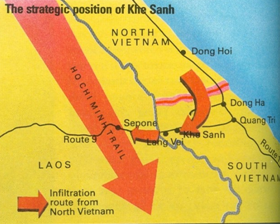 Map #200. Ho Chi Minh Trail to South-Vietnam (1967-1968). North Vietnam sent more than 60,000 troops to attack Khe Sanh, but only 10,000 of those survived that battle, handicapped or badly wounded.
Map #200. Ho Chi Minh Trail to South-Vietnam (1967-1968). North Vietnam sent more than 60,000 troops to attack Khe Sanh, but only 10,000 of those survived that battle, handicapped or badly wounded.
#201
Photos #201 and 202 Defense line around Khe-Sanh in late 1967. Source: “Vietnam. The history and the tactics”)
The US ended up losing an internal political war that led to the inglorious return of the US soldiers who fought in Vietnam. Normally, every activity should be directed at counteracting the enemy’s strategy. However, in this field, the allies did not fully understand the strategy that was often used in hunting wild animals. Normally, the buck never comes out first in the open field; only the doe and the baby deer do. A novice and inexperienced hunter would tend to shoot the female deer or the young deer first, thus allowing the male deer to flee for safety. The Vietnamese soldier is like the male deer and the US soldier deployed to Vietnam is like the novice hunter, who shoots the doe and the baby deer first.
The communists liked to use children to plant bombs, and gave women a role to play in a war that was fought using all kinds of tactics, some of which fell under the psychological warfare portfolio. They used the words “people troops” and “people army” in that general context. In addition, the communists liked to use common citizens as human shield because they knew that the US would not shoot at unarmed people. The US presence in Vietnam was only of a supportive and defensive nature, with a lot to lose and nothing to gain. The plus sign was to split the communist world and generate new thinking. Currently, most of the communist world has changed a lot, with some communist countries changing faster than others. Changes that occurred in Russia and mainland China are good examples. It was only fair that the US assigned itself the task of controlling situation in a world that was being affected by communist expansion and was unable to defend itself. Laos, Thailand, Cambodia and South-Vietnam were among those countries needing help. Absent a world super power, this world of ours would be insecure because many countries cannot defend themselves.
The mainland China-Soviet Russia border conflict gave an opportunity for communist Vietnam to receive all kinds of weapons from Russia for use in their fight against the US. As a result, North-Vietnam became a pro-Soviet country, which prompted Mao Zedong to ask for continued US presence in Indochina until 1972 and to state he would be open for a meeting with President Nixon.
In 1972, several Neo Lao Hak Xath leaders at the ministerial level had told Vientiane leaders, “Our feet are floating in the air with nothing to stand on. We need to help each other!” Phagna Touby Lyfoung and Gen. Vang Pao were both aware of the situation but failed to pay enough attention to it, because, so far, what the Pathet Lao or the Lao communists said has always been mostly misleading and/or unreliable. In 1974, Gen. Vang Pao was invited to a meeting at the royal palace in Louang Prabang. At that meeting, Prince Souphanouvong handed out a note to Gen. Vang Pao’s personal security guard and told him, “Please give this note to Gen. Vang Pao.” The note read, “Request a personal meeting with you, General, to discuss the downtrend slide of our country.” But Gen. Vang Pao remained silent and did not pay any attention to the message. Based on his experience, the Pathet Lao never executed what was discussed or agreed to in written documents. They only misled people and executed North-Vietnam’s policy.
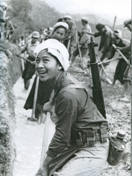 Photo # 203. A Thai Dam woman doing excavation work on the road leading to Dien-Bien-Phu in 1954.
Photo # 203. A Thai Dam woman doing excavation work on the road leading to Dien-Bien-Phu in 1954.
Personal Appeal from Souphanouvong
(Prior to his death, written in 1993)
Reference: Stalking the Elephant King, by Christopher Kremmer
[Christopher Kremmer was an Australian journalist who was interested in south-east Asian and had written several books on the war in Vietnam and Laos. Even after the US had left Vietnam, Laos and Cambodia behind to face their own destinies under communist control, he still maintained that interest, especially in the Laos situation. He tried many times to come and see for himself what it was like, but has not been able to penetrate the bamboo wall that the Lao communists erected in secret. After the collapse of the communist regimes in Europe, Lao communist leaders had to open the door for foreign assistance to pour in. Australia was one of the donor countries. The Lao communist leaders were then not able to continue to prevent Australian journalists from visiting Laos. As a result, Christopher Kremmer was able to enter Laos in the end of 1993].
His main objective was to find out more about the fate of H.M. the King and his family, who had disappeared since 1976. Using his journalist’s connections, he was able to meet with Prince Souphanouvong, who was then gravely ill and under treatment at his residence at Phone Sa-Aath. On that occasion, Prince Souphanouvong provided details on his relationships with Vietnam and asked to issue his final message to all the Lao natives in the following paragraphs.
“Because I worshiped woman’s beauty, I became deaf and blind throughout my whole life. It’s only until now that I realize it was a big mistake of mine. I didn’t think that the Vietnamese had such a secret plan to destroy my country and my countrymen. During all the time that I collaborated with the Vietminh in the fight for independence, we had agreed that once the fight ended, Vietnamese would go back to Vietnam and that Lao would go back to Laos, irrespective of the fact that we have a Vietnam-Laos friendship treaty in place.
“I do not know when they were going to cremate my body, but I know that everything they have done to my country would not be erased after I stopped breathing and after my body is cremated. Up to now, I have not been able to speak up, only keep everything in the back of my mind. Therefore, in view of the currently dangerous situation in my country, I would like to appeal to all my countrymen, including women, men, nieces and nephews of all Lao ethnic groups, and elders who are still healthy, to unanimously forgive me for all the mistakes that I committed toward our Lao country and our Lao people.
“Now, I’m no longer a patriot and someone who is looking for things that are beneficial to my country, because I had been betrayed. Once you folks have a chance to listen to or read my appeal, please take your thinking in a new direction in order to defend your country and the natural resources of the population, and most importantly, maintain your “Lao roots” pride for ever.
“My dear countrymen, especially those of you, brothers, sisters, and nieces and nephews living abroad who sincerely love your country and your race, can see far, and are well-educated, remember that your patriotism is deep and, please, don’t let your country disappear. For those of you who live inside the country, you must adjust yourselves, love each other, move together in a new direction, and more importantly, follow the lead of your relatives who live abroad. If you understand correctly the situation of our country and listen to my appeal, you will have a stable and honorable future. Before I die, I would like to leave this appeal with you all. Please, be patient and keep fighting hard. I am convinced that our country will survive and remain Laos forever.”
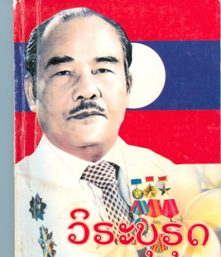 Photo #204 Tiao Souphanouvong not long before he passed away.
Photo #204 Tiao Souphanouvong not long before he passed away.
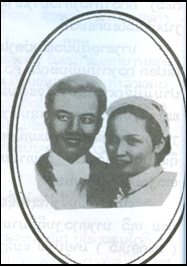 Photo #205 Taio Souphanouvong and his wife, Mom Viengkham, the day of their wedding in Nha-Tranh on Januray 19, 1938. Mom Viengkham (nee Nguyen Thi Kinam) was an educated Vietnamese lady.
Photo #205 Taio Souphanouvong and his wife, Mom Viengkham, the day of their wedding in Nha-Tranh on Januray 19, 1938. Mom Viengkham (nee Nguyen Thi Kinam) was an educated Vietnamese lady.
Phoumi Vongvichit
Phoumi Vongvichit was born on May 6, 1909 and died on July 1, 1994. He fought as a true nationalist for Laos’ independence from 1945 to 1975 alongside communist North-Vietnam. He did remove a wooden plough from the people’s neck, but soon replaced it with a heavier, steel plough. That’s how things are today, when communist Viet-Nam is controlling everything in Laos. He signed the agreement that led to the formation of the third Lao coalition government in 1973, together with Pheng Phongsavanh, a fake agreement that could not be used by the Lao people –only by the Vietnamese communists. Kaysone Phomvihane later signed a treaty that allowed for Vietnam to come in and rule Laos for 25 years on July 18, 1977, a treaty that may be extended for unlimited, consecutive 10-year terms.
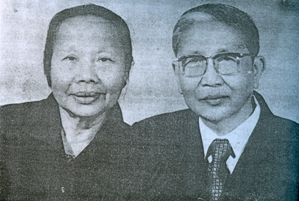 Photo #206. Phoumi Vongvichit and his wife. Photo taken in 1979 in Vientiane.
Photo #206. Phoumi Vongvichit and his wife. Photo taken in 1979 in Vientiane.

